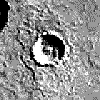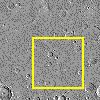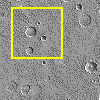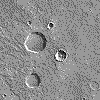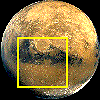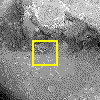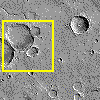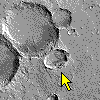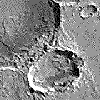- The other one is located in the Sinus Sabaeus region, south of the
Schiaparelli impact basin.
The second crater (23x15 km) is at latitude -14 longitude 343.5.
It is superposed on the rim of a larger, rimless crater. It has a nice
asymmetric ejecta blanket that flows into the floor of the larger rimless
crater.
- There is a feature that looks like a river in the upper (northern)
side.
-- The channel is called Evros Vallis. It is one of many channels
formed early in martian history (within about the first billion years or
so of the planet's history). The origin of these channels is debated. They
are most likely formed by flowing water, but of course current atmospheric
conditions on Mars prevent the existence of liquid water on the surface.
One idea to explain the channels is that atmospheric conditions were different
in the past on Mars, that the atmosphere was thicker and thus water could
exist on the surface. Some speculate that perhaps Mars even had rainfall
during this time. So this theory says that the channels were formed by
flowing water across teh surface of Mars, similar to the way terrestrial
river channels form. Another idea is that the channels are formed by flowing
water, but the water is underground. As the underground rivers dry up,
the overlying surface material loses the underlying support and the material
collapses, creating a surface expression of the underground river's course.
- The larger crater seems very deep. Could it had been a lake?
-- Maybe, although without any channels crossing the crater rim,
the source of the water is speculative. Another possibility is that the
flat floor is simply due to infilling by wind-blown dust over the ages,
since this crater (based on its degraded state) is likely about 3.5 to
4.0 billion (10^9) years old.
- Why is darker the lower right part of the floor of the largest craters?
(light seems to come from the upper right side)
-- The dark area appears to be a deposit of darker material. Since
it crosses the same area of the three in-line craters, it may be a subsurface
deposit excavated by all three. However, since all three of those craters
have infilled floors, I would suspect that any such deposit would have
been covered up by the later sediments. Thus, I suspect that it may be
a dark deposit emplaced over that region at a later time, perhaps by wind-
blown processes. Interiors of craters are generally protected by their
walls from later wind erosion, so a deposit emplaced over the area could
be eroded away from areas outside the craters but left in place inside
the craters.
- Why the ejecta blanket seems to spread transversally respect to the
long axis of the elliptical craters?
-- Laboratory studies indicate that in low-angle impacts (<15
degrees to the surface) most of the ejected material ends up being ejected
to the side of the crater due to the process known as jetting. Thus an
asymmetric ejecta blanket is always a clue to a low-angle impact, regardless
of whether the crater is elliptical (which occurs for impacts at less than
about 10 degrees to the surface) or not (such as you see for Crater 1).
- Is only a coincidence that the little elliptical neighbour some 15
km to the north had the same orientation and shape?
-- Coincidence is always a possibility. Alternately we now know that
many asteroids are actually double (two objects of about the same size
orbiting around a common center of gravity) or have small moons accompanying
them. It's possible that the meteorite that created the large elliptical
crater had such a companion that impacted nearby, creating the smaller
elliptical crater. Unfortunately without any age data for either of these
craters, that idea cannot be tested at this time.
